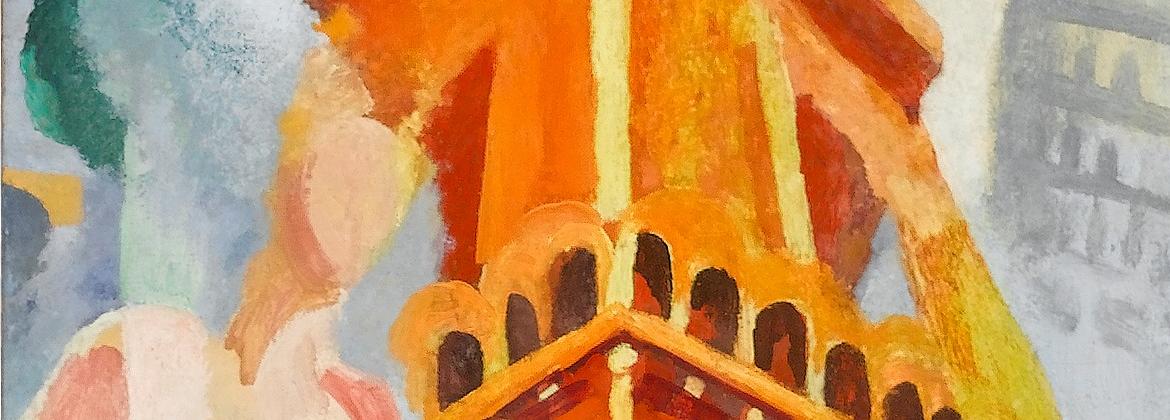From the Belle Époque to the Roaring Twenties, Paris continued, more than ever before, to attract artists from all around the world. This cosmopolitan city was both a capital where innovation thrived and a place of tremendous cultural influence. It brings together almost four hundred works by Robert Delaunay, Sonia Delaunay, Marcel Duchamp, Marie Laurencin, Fernand Léger, Tamara de Lempicka, Amedeo Modigliani, Chana Orloff, Pablo Picasso, Marie Vassilieff, and many others. It also features clothing designs by Paul Poiret and Jeanne Lanvin, jewellery by Cartier, a plane from Le Bourget Musée de l’Air et de l’Espace, and even a car on loan from the Musée national de l’Automobile in Mulhouse. Through fashion, cinema, photography, painting, sculpture, and drawing, as well as dance, design, architecture, and industry, this exhibition showcases the rich creativity of the period 1905-1925.
The exhibition, organized both chronologically and thematically, draws its originality from the geographical perimeter on which it mainly focuses, i.e., the Champs Élysées. This district was a veritable cradle and hub of Modernity. At the time, the Grand Palais hosted the latest in artistic creation at the Salon d’Automne and Salon des Indépendants every year, where the public could discover works by Douanier Rousseau, Henri Matisse, and Kees van Dongen amongst others.
 During the First World War, the Petit Palais played an important patriotic role, exhibiting works of art that had been damaged during the conflict, as well as Mimi Pinson cockade (tricolour rosette) competitions. In 1925, it hosted the International Exhibition of Modern Decorative and Industrial Arts, displaying an exciting mix of traditional, Art Deco, and international avantgarde productions. A few steps away, on the currentday Avenue Franklin Roosevelt, at that time called the Avenue d’Antin, the great fashion designer Paul Poiret earned a reputation for his lavish costume parties, such as “The Thousand and Second Night” held there in 1911. His mansion also housed the Galerie Barbazanges, where Picasso’s Young Ladies of Avignon was exhibited for the first time in 1916.
During the First World War, the Petit Palais played an important patriotic role, exhibiting works of art that had been damaged during the conflict, as well as Mimi Pinson cockade (tricolour rosette) competitions. In 1925, it hosted the International Exhibition of Modern Decorative and Industrial Arts, displaying an exciting mix of traditional, Art Deco, and international avantgarde productions. A few steps away, on the currentday Avenue Franklin Roosevelt, at that time called the Avenue d’Antin, the great fashion designer Paul Poiret earned a reputation for his lavish costume parties, such as “The Thousand and Second Night” held there in 1911. His mansion also housed the Galerie Barbazanges, where Picasso’s Young Ladies of Avignon was exhibited for the first time in 1916.
After the war, the Galerie Au Sans Pareil on the Avenue Kléber opened its doors to Dada and Surrealist art. On the Avenue Montaigne, the Théâtre des Champs-Élysées hosted ballet productions by the Russian, and later Swedish Ballet Companies up until 1924, with works like Relâche and The Creation of the World. In 1925, Josephine Baker caused a sensation there with the Revue Nègre. She frequented cabarets like Le Boeuf sur le Toit which opened in 1922 on the rue Boissy d’Anglas and where Jean Cocteau attracted many of the capital’s socialites.
This history of “Modern Paris” was marked by numerous “accidents” and dramatic events. The scandals that punctuated artistic life are touched upon here: from the “wild beasts’ cage” (cage aux fauves) and the “Kubism” of Braque and Picasso to the highly erotic Nijinsky performing as a faun in The Rite of Spring, produced by the Ballets Russes in 1913. Modernity assimilated all these scandals with many of them becoming key stages in the consecration of certain artists.
Modernity also involved progress in the fields of technology and industry. Speed was of the essence with the development of bicycles, automobiles, and airplanes, to which trade fairs were dedicated at the Grand Palais. This exhibition, which features an airplane and a Peugeot car, shows how the popularity of such fairs with artists like Marcel Duchamp and Robert Delaunay had a lasting influence on their work.
The role of women during this period is highlighted throughout the exhibition. From 1905 to 1925, French society experienced dramatic social upheavals. Artists like Marie Laurencin, Sonia Delaunay, Jacqueline Marval, Marie Vassilieff, and Tamara de Lempicka held an important place in the avant-garde. A symbol of female emancipation, the figure of the flapper was immortalized in Victor Margueritte’s novel in 1922. With her short stature and slim waist, Josephine Baker was the embodiment of this freedom. Josephine Baker was just one figure in a growing multicultural movement within French society. Aïcha Goblet for example, a renowned artists’ model of West Indian origin, was immortalized in works by Félix Vallotton.
From the underground arts scene to elite social circles, well-known figures like Max Jacob and Gertrude Stein strove to build bridges: poor artists rubbed shoulders with the rich in Montparnasse, and the luckiest amongst them attracted the attention of generous patrons such as Chaïm Soutine or American billionaire Albert Barnes. A beacon for artists and tourists from all over, Paris was truly the “international capital of the world”.
The scenography designed by Philippe Pumain immerses visitors in this fascinating epoch, punctuated by a selection of films by René Clair, Fernand Léger, and Charlie Chaplin.
Curators:
Annick Lemoine, Director and Head Curator of the Petit Palais
Juliette Singer, Chief Heritage Curator, Curator of Modern and Contemporary Art at the Petit Palais
Recap of the study day dedicated to Joséphine Baker and organized with the support of FRAME


